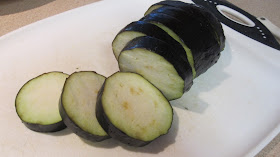Eggplant is a food I grew up believing I disliked. It was not until the last couple of years I've been willing to try dishes that include it in it and I've found I can enjoy it.
I've had eggplant in a Thai salmon curry, in a Malaysian striped sea bass dish, in a Greek vegetable wrap with hummus, and in baba ghanoush, all of which I've really liked. I recently took my eggplant precocity to another level. I purchased an eggplant and made a dish that includes it. Eggplant is one of the 1001 Foods You Must Taste Before You Die. It is a vegetable, but botanically a berry.
The traditional eggplant I see is a Mediterranean variety with a smooth purple skin. It is white inside with white seeds,
but rather quickly starts to turn brown when you cut it open.
It is lighter and spongier than I anticipated. I always thought it was more dense. I found a recipe at eggplantrecipes.net for grilled eggplant. I preheated my outdoor grill to medium and seasoned it with olive oil. I cut the eggplant into approximate 1/2 inch slices and rubbed the slices with olive oil.
I was surprised at how quickly the eggplant absorbed the olive oil. I initially put a few drops on each piece and went back to rub it in. It had all been soaked up. So I put some oil on each slice and immediately spread it around to get some coverage. The recipe called for mixing 1/2 cup of crumbled feta cheese with a tablespoon of fresh oregano as a topping. I substituted a tablespoon of basil pesto for the oregano and added some salt and pepper.
Feta cheese is another of the 1001 Foods and I have grown to appreciate it much more since our trip to Greece last summer. After an apparent court battle, since 2007, feta cheese must be made in Greece from the milk of sheep and/or goats to be called feta. The curd is salted and dried for 24 hours and then matured in a brine bath for a month or so. In Greece, it is placed in a large chunk in a Greek salad with olive oil and lemon juice and the taste is amazing. Judy has found it at Trader Joe's for sale in brine and the taste is much more like what we had in Greece. The feta I used for this dish did not include the the best kind of feta, but it was still good.
Genoese pesto is another of the 1001 Foods. Pesto comes from the Italian verb pestare, which means to crush. Genoese pesto is made using a mortar and pestle and includes Ligurian basil, olive oil and other ingredients such as garlic, pine nuts, salt and Pecorino and or Parmigiano-Reggiano cheese. The pesto I used is from Italy and had all of the foregoing ingredients.
I grilled the eggplant for several minutes on each side, then put on more olive oil and sprinkled on red wine vinegar.
Varietal red wine vinegar is another of the 1001 Foods. The name vinegar comes from the French words vin aigre meaning sour wine. Vinegar is formed when the bacterium Acetobacter xylinum converts alcohol into acetic acid. For wine vinegars, the grapes are allowed to ferment into wine and then a bacterial culture takes months after that to do the acetification. It can take months or years for a good vinegar to mature. The better vinegars come from the better base wines. The best red wine vinegars come from "single varietal wines produced in the famous red wine regions of the world," such as Piedmont. I suspect the red wine vinegar I used was not from a single varietal wine.
Anyway, moving on, I added the feta/pesto combination to the eggplant . The eggplant just soaks in the flavors and takes on the flavor of whatever is on it. The grilled eggplant was soft, had a little grill taste to it, and the pesto/feta combination was good.
Judy thought it had too much feta and took some of it off, but commented that it was some of the better eggplant she's eat (she too, has not been an eggplant fan).










No comments:
Post a Comment